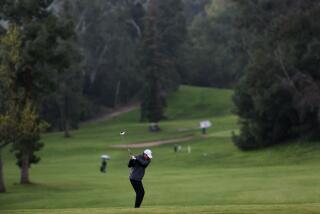COLUMN ONE : First and last tee at the DMZ : The golf course along the Koreas’ frontier has a single hole, but myriad obstacles. Not the least of which is a minefield in the rough.
- Share via
U.S. ARMY CAMP BONIFAS, SOUTH KOREA — You stand atop an elevated tee box on the first and only hole of the world’s most dangerous golf course.
And you consider your chances.
This deadly little par 3 measures 192 yards but plays more like 250 in the face of the vicious winds that often blow out of North Korea across an exclusive piece of real estate called the DMZ just a few yards away.
Underneath your feet and off to the right are bunkers. The military kind. To the left, over an 18-foot-high security fence topped by concertina wire, are hazards that make high rough, deep water and dense woods seem like child’s play.
Try countless unexploded mines -- the very definition of out-of-bounds. One herky-jerky backswing, one snap hook yanked out of your bag at the wrong moment and . . . ba-boom!
A sign nearby drives the point home: “Danger. Do not retrieve balls from the rough. Live mine fields.”
“Oh, dear Lord,” moans one of your two playing partners, Army Sgt. Mikel Thurman. “You know what would make this play easier? Let’s go get the keys and open the bar.”
The course is called Camp Bonifas. It’s named in honor of Capt. Arthur Bonifas, who was axed to death by North Korean soldiers in 1976 during a disagreement over a tree-pruning project along the DMZ, or demilitarized zone.
Built four years earlier, in 1972, the course provides a much-needed emotional outlet for the 50 U.S. soldiers stationed here at a lonely outpost without theaters or restaurants. There’s no night life, unless you count listening to the taunts of the North Korean soldiers stationed just within earshot.
“It’s like a Zen garden where we hit little white balls,” says Thurman, 41, an Army brat who was born in Seoul.
When they built the course, commanders figured that if they couldn’t fit in all 18 holes in the compact camp, they’d compensate by making it difficult. They’d match their skills against one tough little customer they wouldn’t soon forget.
The result is a layout that slices through dense rows of trees, along a fairway that’s a mere 40 yards wide. Forget about playing an iron here. This is all wood, baby. Give it your best shot.
“Most golf holes would get boring if you played them again and again,” says Sgt. James Meisenheimer, a 23-year-old Kansas City native. “This one doesn’t.”
For years, when more than 700 Americans were stationed here, the course was kept in pristine condition, the fairway and green mowed almost daily. (On a U.S. Army base, labor is cheap.)
But as the number of men dwindled along with military budgets, the Camp Bonifas tract fell on hard times. The killer course became a cow pasture.
Not long ago, the hardy hackers here decided to do something about that. They gave their course a face-lift, brought in a construction crew to fix the fairway and clean up the two sand traps. They shipped in a riding lawn mower from the States and installed Astroturf on the tee box and green, giving each a greased-lightning tabletop-hard roll like Augusta on a Sunday afternoon.
The soldiers say they’re not done yet.
“We’re hoping Tiger Woods will come play here and we’ll get the money to do a better job,” says Command Sgt. Maj. Andres Ortiz.
Maybe he can do what no one else has done: hit a hole-in-one. Just hitting par is rare. And nobody goes looking for lost balls.
Over the years, the course has developed its own mystique. Play alone here and you’ll see. Weird things happen.
“You see animals,” Thurman says.
Like wild boars, Korean tigers and so-called vampire deer.
And even something weirder.
“Some guys say they’ve seen this thing, a man-bear-pig,” Thurman says without smiling. “That’s what they say.”
You play two shots off the tee, just like your playing partners. You’re without golf shoes, a glove, your own clubs. It’s vagabond golf, but you don’t feel out of place.
There’s no attitude here at Camp Bonifas. Meisenheimer, a tough but polite kid who’s spent 15 months in Afghanistan and will become a Green Beret in another year, plays his rounds U.S. Army-style: in combat boots and fatigues.
Some guys carry their military side arms, giving new meaning to playing a “round” of golf.
You hit your driver, spraying your first shot right into the trees. It’s a lousy start, but safely away from the minefield. The second is spanked straight up the middle of the chute, coming to rest just short of the green in one of the traps.
Thurman is a golf beginner, inspired to take up the game after helping to give the course a face-lift. He whiffs, gets nervous, asks for advice and dribbles a shot off the tee.
Meisenheimer, who has played for 10 years, has a knack for the game. His shots fly straight and true.
All playing out of the same bag, you walk up the narrow fairway with your partners and play your shots, crunching over brittle pine needles, passing tables set up for paintball competitions
The ground is a brindle brown, contrasted by the cartoonish lime coloring of the tee box and green. None of it matters. This isn’t pretty golf. It’s Bonifas golf.
The green is a real piece of work. A recent monsoon flooded the ground underneath. Now the big sheet of Astroturf doesn’t sit right and covers half the cup, which is made from an old piece of PVC pipe that sticks out of the ground, repelling balls.
Thurman whacks a putt. “That’s not gonna stop,” Meisenheimer says as the ball rolls off the green.
You’re not paying attention. You’re looking out past the concertina and wondering how many explosives are buried in that field.
When it’s over, when the scores are tallied, you record a 3 and a 6 -- a par with one ball, and a triple bogey with the other.
“Good game,” Meisenheimer says. “You did real well.”
Here at the world’s most dangerous golf course, you figure you did even better.
You took a good walk, unspoiled by penalty strokes and land mines.
--
More to Read
Sign up for The Wild
We’ll help you find the best places to hike, bike and run, as well as the perfect silent spots for meditation and yoga.
You may occasionally receive promotional content from the Los Angeles Times.







